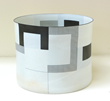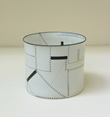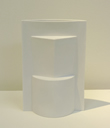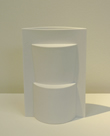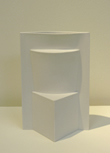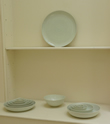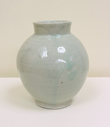POTS FOR LIGHT
New International Porcelain
29 April - 27 May 2009
Special saturday opening - 16 May, 11 am - 5 pm
Porcelain remains one of the most seductive and beguiling of materials, rich in its broad physical properties, from the luminous clarity and geometry of Bodil Manz’s cast vessels – like taut paper – to the ‘liquid’ and gestural qualities of Ryoji Koie’s bowls. It remains a difficult substance to define; traditionally associated with preciosity and the rarefied, it is not only a robust functional body but a material capable of the boldest forms. British potters like Trevor Corser and Jack Doherty challenge preconceptions, treating porcelain much as one might stoneware, solidly and freely. Doherty recalls an epiphany moment on finding an ancient Korean porcelain jar in the Ashmolean Museum “with the top a good inch thick”, reminding us of its long history of more spontaneous making in the Far East, one that potters like Corser and Doherty have helped to reclaim for modern living.
The origins of Daniel Smith’s crisp white and celadon table porcelain lies more in the spare functionality of 18th and 19th century factory creamwares and Bauhaus ceramic design than handcraft. His are objects of an almost industrial austerity. Gwyn Hanssen Pigott and Helen Felcey (who uses the bone china variant of ‘true’ porcelain) take something as deceptively simple as a bowl – glowingly translucent, sometimes squeezed into an ellipse – to create new and rhythmic still lifes for the shelf and table surface. Prue Venables and Suku Park use function as a basis for their own inventive renewals of familiar shapes. Like Hanssen Pigott, they are intrigued by the way simple contrasts and unities of colour add their own rhythm and counterpoint. How different is Dan Kelly’s approach. His thickly thrown vessels delight in porcelain’s richly ‘unctuous’ qualities (a phrase this potter loves), a sensual ‘oiliness’ you particularly find in Masamichi Yoshikawa’s broadside architectonic slab constructions, objects with strong affiliations to traditional vernacular structures.
Pots for light? The poetic receptiveness and sensitivity of porcelain to daylight is of course only one aspect of its character. Certainly Howard Smith’s translucent and intimate cast pieces are only fully revealed when you hold them to the window – and every object here reflects and absorbs the changing atmosphere in its own particular way. But porcelain, as the work here proves, continually reinvents itself. This clay is as much about rugged strength and expressive force as precision and control, as much about sensual softness as sharper definition – a material that can be pushed and stretched, but technically is no easy taskmaster. As a maker you have – physically and mentally – to feel your way into it. This challenge to potters is part of porcelain’s lasting attraction, and it continues to yield great surprises both for artist and user.
© David Whiting
Trevor Corser (b. 1938)
Based in St Ives, Cornwall where he was originally apprenticed at the Leach Pottery. He works in the anglo-oriental tradition and makes fine individual pieces in stoneware and porcelain. His porcelain has a particular freedom of execution. For many years after Bernard Leach's death he remained at the Leach pottery, managing it with the late Janet Leach.
Jack Doherty (b. 1948)
Lead potter at the re-established Leach Pottery Museum in St Ives, Cornwall. A former chairman of the Craft Potters Association, and currently serving on its council, he has an international reputation for his soda-glazed porcelain, treating this material with the robustness of stoneware.
Helen Felcey (b. 1979)
Trained at Manchester Metropolitan University and Cardiff School of Art. She produces vessels and utensils in bone china, making rhythmic grouping that explore the translucency and purity of this material. She currently teaches at Manchester Metropolitan University.
Dan Kelly (b. 1953)
Trained at the Camberwell School of Arts and the Royal College of Art, before setting up studios in London with the help of a New Craftsman grant from the Crafts Council in 1980. He has exhibited widely, and was included in Galerie Besson's "Camberwell in the 1970's" exhibition in 2005. Works in both porcelain and stoneware.
Ryoji Koie (b. 1938)
Considered one of Japan’s most innovative ceramic artist’s, his highly spontaneous work has twice been exhibited at Galerie Besson. The porcelain pieces on exhibition here were produced whilst working at the studio of Oxford potter Margaret O’Rorke.
Bodil Manz (b. 1946)
World-reknowned porcelain artist, awarded the Grand Prize at the 4th World Ceramic Biennale, Korea in 2007. Lives and works in Copenhagen where she produces highly translucent, cast porcelain cylinders decorated with blocks of colour and graphic patterns. Her work is represented in public collections worldwide.
Suku Park (b. 1947)
Korean potter who lived in Finland for a number of years. Is renowed in both in Europe and Asia, for his work which is "as aesthetically refined and impressive as technically sophisticated". He is Professor of Ceramics at Sangmyung University in South Korea.
Gwyn Hanssen Pigott (b. 1935)
Trained with Ivan McMeekin in New South Wales and worked with Ray Finch, Bernard Leach and Michael Cardew in Britain. Set up studio, first in London in 1960 and later in Acheres, France, she returned to Australia in 1975 and has lived and worked there since. Has exhibited extensively in Australia, America, Europe and Asia and is the recipient of many awards.
Daniel Smith (b. 1971)
Daniel Smith produces a wide range of hand-thrown porcelain tableware. His honest and simple approach results in an understated elegance. The weight of the porcelain in the hand combined with the pure delicate forms makes each piece a delight to hold and use.
Howard Smith (b. 1928)
American-born artist Howard Smith has lived in Finland for over 40 years. He works in a diverse range of media - he has produced works in wood, ceramic, glass, textile and on canvas, and has had a prolific career as a designer for prestigious firms such as Arabia, Iitala and Vallila Interiors. The two porcelain cups in this exhibition were made in collaboration with Suku Park.
Prue Venables (b. 1954)
Trained and taught at Harrow College of Art before returning to her native Australia where she has established an international reputation. Her delicate porcelain pieces combine "stillness and a sense of risk", the apparently simple porcelain objects disguise the laborious making process involved.
Masamichi Yoshikawa (b. 1946)
One of Japan's most distinguished potters. He uses white and blue/white porcelain, producing vessels and bold constructions that explore the plasticity and freedom of the material. The recipient of numerous international prizes, he was awarded the grand prize at the 2004 Taiwan International Ceramics Biennale. His previous major London showing was in 1998 at the Daiwa Foundation.
Exhibition curated by David Whiting, who would like to thank the featured artists and Galerie Besson for their help and support.




